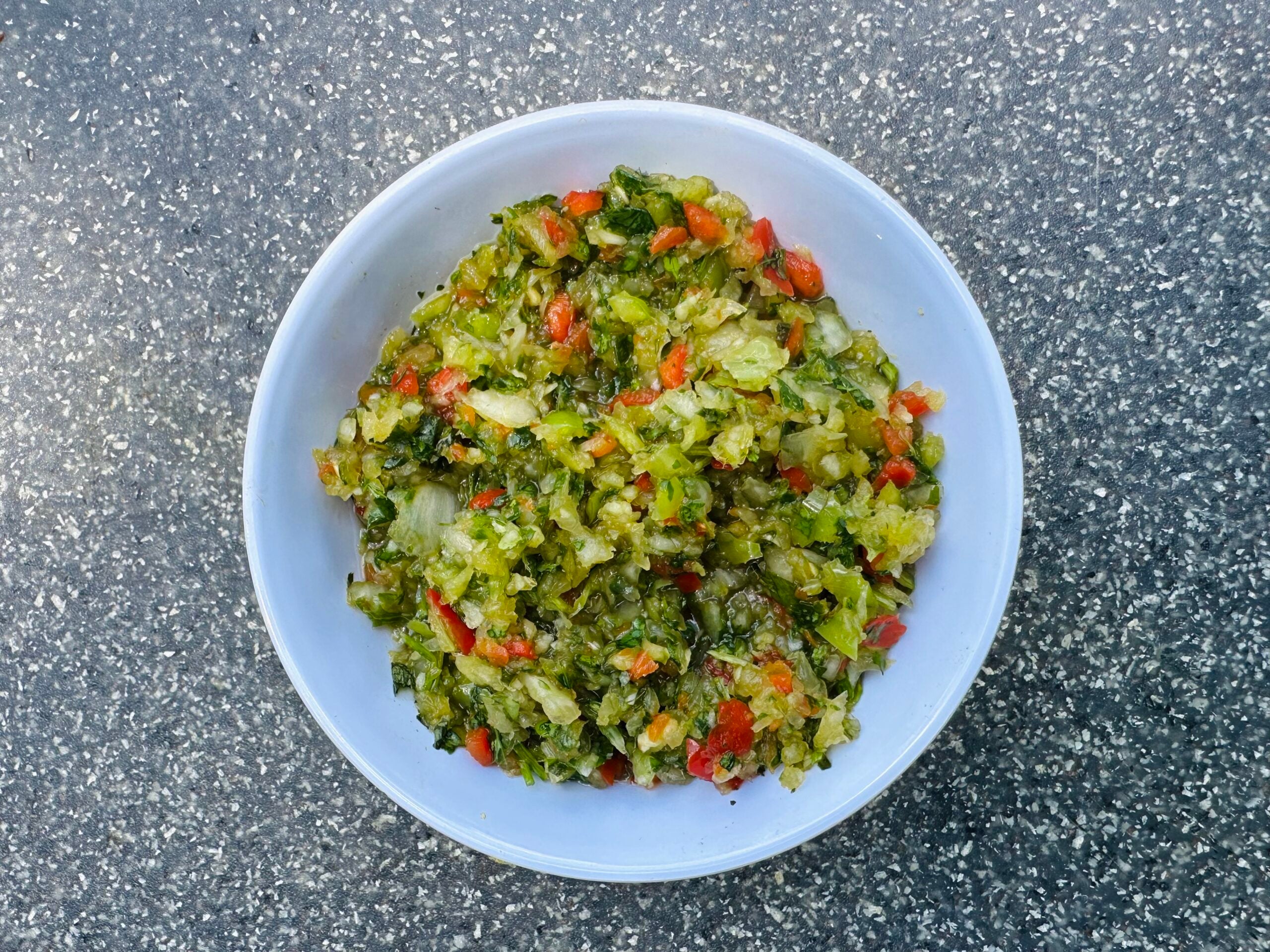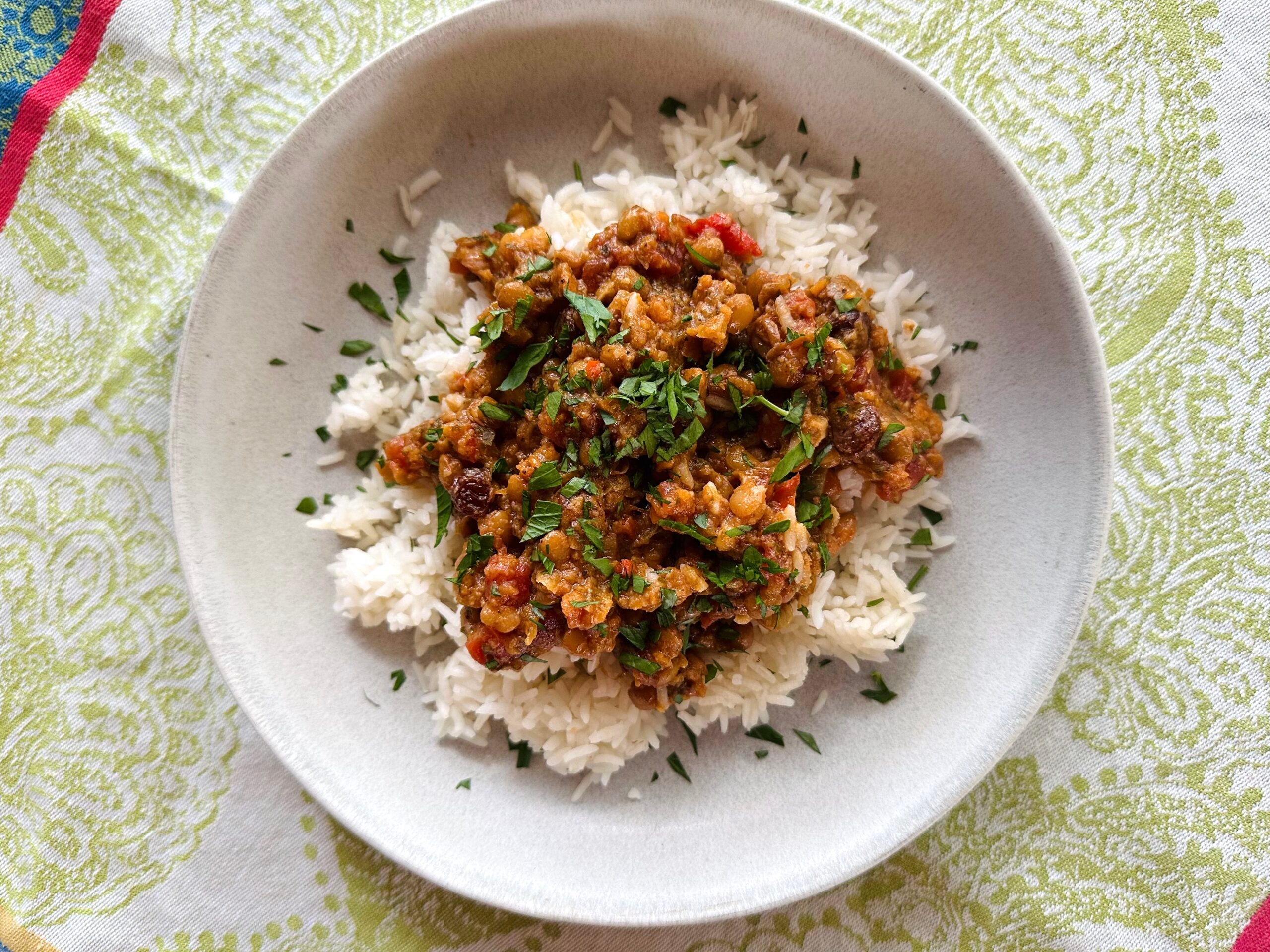Editor’s Note: Hi, I’m Corinne, editor-in-chief of Cool Beans. A lot of you are new, so I figured I’d take a minute to give you an editor-in-brief look at what we’re about: saving the world by eating delicious food that just happens to be sustainable. Cutting mealtime emissions can mean a lot of things, but often it means eating more plants. In fact, this week, a new analysis found that trimming just half the animal products from our diets can cut agricultural emissions by 31%. Yup: You don’t need to go vegan to make a huge dent.
Displacing meat starts with your pantry. We recently laid out must-stock staples for sustainable eating success, but that mostly covered the typical “American” menu. There’s a huge world of exciting cooking to explore, so, from time to time, we’ll check in with chefs and experts about the ingredients and flavors that unlock cuisines from all over the globe.
Our ace food writer Gabriella is kicking things off this week by opening up her cupboards to show us how she adapts the staples of Puerto Rican cooking for meatless meals—including a super-quick, veggified spin on a mainstay supper. Plus, paid subscribers also get her back-pocket recipe for sofrito, the blend of aromatics that underpins almost every savory dish on the island.
If you think that sounds delicious, please share us with your hungriest friends.
Now, let’s get to it…
Puerto Rican cuisine is a melting pot. It blends indigenous Taíno ingredients like yucca and corn, West African cooking techniques like stewing, and Spanish colonial influences like the introduction of rice and oil (and the idea of frying). Also, given that more than 80% of the food on the island is imported, there’s a big reliance on American canned convenience foods. All this converges to create some of the island’s definitive dishes, like picadillo, a seasoned ground beef supper, and sofrito, a flavorful blend of aromatic veggies and herbs that serves as the foundation for most savory recipes. Most of our fridges and freezers, mine included, are stockpiled with the stuff.
This week, I’m digging into how it—plus a few other shelf-stable essentials—can get you one step closer to quick, meatless island meals.
The review: This lentil picadillo was made for weeknights
Puerto Rican cuisine can be heavy on meat, and picadillo is a prime example. The simmered ground-beef dish crops up everywhere: over rice, in a casserole called pastelón, or stuffed in a fried pastry. Learning how to cook plant-based versions of these mainstays is a challenge, because the meat acts as the sponge for all the underlying flavors, starting with the sofrito at the very beginning of the cooking process.
Over time, I’ve found that lentils, one of my pantry go-tos, are a great substitute. Plus: The legumes absorb all the goodness from the sofrito in a fraction of the time as meat. A great example of this is Washington Post food writer G. Daniela Galarza’s plant-based picadillo, which is built around two things: a bomb sofrito and canned lentils. All the basics of the classic preparation are there, including raisins and olives (a combo that distinguishes Puerto Rican picadillo from other versions), tomatoes, and sazón seasoning. She does incorporate a couple interesting twists—namely a splash of soy sauce for an umami kick—but the biggest difference is the sofrito.
Check out the full vegan picadillo recipe at the The Washington Post
Puerto Rican sofrito is typically a medley of onions, garlic, peppers, and culantro, a spiky-leafed cousin of cilantro. Galarza’s slightly earthier version adds mushrooms and carrots, which is a great reminder that picadillo is the perfect place to stash veggies that have been lingering in the fridge. I can see myself making this often. The canned lentils make it super weeknight friendly, though cooking your own might add a little more bite.
All the sweet-savory-briny notes that make picadillo so satisfying are still there, but in far less time: Normally I would simmer the ground beef in sofrito for 15 minutes, but the canned lentils got the job done in five. Next time I make it, it will go even faster (and dirty fewer dishes) because I’ll reach for the mealtime cheat-code in my freezer: cubes of sofrito ready to hop in the pan and sizzle in seconds.
The recipe: A make-ahead flavor hero to stash in your freezer
Almost every place has its version of sofrito—from French mirepoix to Cajun cooking’s holy trinity—but the general idea is the same. Veggies and herbs get chopped into tiny pieces and sautéed in oil or butter at the start of a dish. While it eventually disintegrates, the mix adds big flavor that lingers. In Puerto Rico, sofrito is called recaito and gets its definitive taste from culantro (or recao), a long, dark-green herb that tastes like super-strong cilantro.
Recaito is used as a starter for soups, stews, beans, rice, and braises. You can buy it jarred, but making your own is a one-shot dump into the food processor. One batch will also last a long time, especially if you freeze spoonfuls in ice-cube trays and de-mold them into an airtight freezer bag or container. Paired with shelf-stable goods like rice and beans, one or two cubes in a pot or skillet is the starting point for many of the island’s signature dishes.

Puerto Rican Sofrito (Recaito)
Yield: about 2 cups
Ingredients:
6 large garlic cloves
1 large yellow onion, coarsely chopped
4 ají dulce peppers, seeded and coarsely chopped
1 cubanelle pepper, seeded and coarsely chopped
1 small bunch cilantro, about 1 cup
6 leaves culantro
Procedure:
Add the garlic to a food processor and pulse to chop.
Add remaining ingredients and pulse to combine. Some people take it to a full purée, but I prefer to keep mine slightly textured, like a tapenade.
Store in the refrigerator for up to a week or the freezer for 6 months.
Notes and Substitutions:
A small red bell pepper can swap for ají dulce, and green bell pepper can stand in for cubanelle.
If you can’t find culantro, just swap more cilantro.
The shopping list: 13 Puerto Rican pantry essentials
Now that we have the ultimate Puerto Rican freezer staple, we can explore the other ingredients I keep on hand for Caribbean cooking. Together with a stash of recaito, these staples form the basis of dozens of island classics. (Not every savory dish starts with sofrito, but most do; they’re marked with an 🧅.)
Coconut milk. A stockpile of coconut milk is great for making coquito (an eggnoglike drink) to give to friends and family around the holidays. Otherwise it’s good for desserts, like tembleque pudding, and caldo santo 🧅, a seafood and root-veggie stew.
Distilled white vinegar. With the exception of a chile-laced vinegar known as pique, Puerto Ricans do not use much intense spice. Many dishes instead feature a flavor sensation we call agridulce (sweet and sour). Vinegar is key to developing that profile.
Annatto oil. Annatto is the seed from the achiote tree. It has a mild earthy and peppery flavor and vivid red color that we use to infuse cooking oil and add a yellow-orange hue to foods.
Sazón. The spices used in this all-purpose seasoning vary across brands and recipes but typically include a blend of salt, cumin, coriander, garlic, pepper, oregano, and annatto seeds for color.
Manzanilla olives and capers. You’ll often see either (or both) of these ingredients as a means to bring a briny element to rice dishes and casseroles—and picadillo of course. Together with piquillo peppers, the ingredients form a condiment called alcaparrado.
Rice. Medium-grain white rice serves as the bed for all the classic rice dishes, including mamposteao 🧅 (my favorite!), a cozy comfort dish of leftover beans mixed together with day-old rice.
Beans. Habichuela rosadas, or pink beans (canned or dried), are the most common in our household for making habichuelas guisadas 🧅, a stewed bean dish with Caribbean pumpkin.
Gandules, aka pigeon peas. These tiny legumes are green when fresh and beige/brown when canned. They’re the foundation of our signature dish, arroz con gandules 🧅, or pigeon pea stew 🧅 with plantain dumplings.
Tomato sauce. A shortcut for adding tomato to a sofrito, a base for beans and stews, or for making salsa criolla 🧅, a tomato sauce typically spooned over mofongo 🧅.
Raisins or golden raisins. This is a pretty specific addition for picadillo, but the little gems are also used as a filling for savory pastries 🧅.
Cornmeal. For making funche, a dish similar to grits or polenta made with coconut milk, or sorullitos, my childhood favorite (highly addictive) corn fritter snack.
Guava paste. A must for baking pastries, but it’s also great in savory applications like guava BBQ sauce.

